Case Study: Analyzing R3's Fintech Strategies in Finance
VerifiedAdded on 2022/08/29
|6
|1068
|22
Case Study
AI Summary
This case study analyzes the role of R3 in the Fintech industry, examining the main issues, the meaning of Fintech, and R3's core businesses. It explores Distributed Ledger Technology (DLT) and its applications, particularly how R3 utilizes DLT to bridge the gap between finance and technology through its Corda platform. The analysis delves into R3's strategies for the future, including its differentiation through customer investments, DLT utilization, and an open-source platform, while also addressing the risks and challenges, such as expanding in the Fintech industry of China and managing financial agreements. The study provides a comprehensive overview of R3's impact on financial services and its efforts to integrate finance and technology, ultimately highlighting its strategic approach to navigate the evolving Fintech landscape.
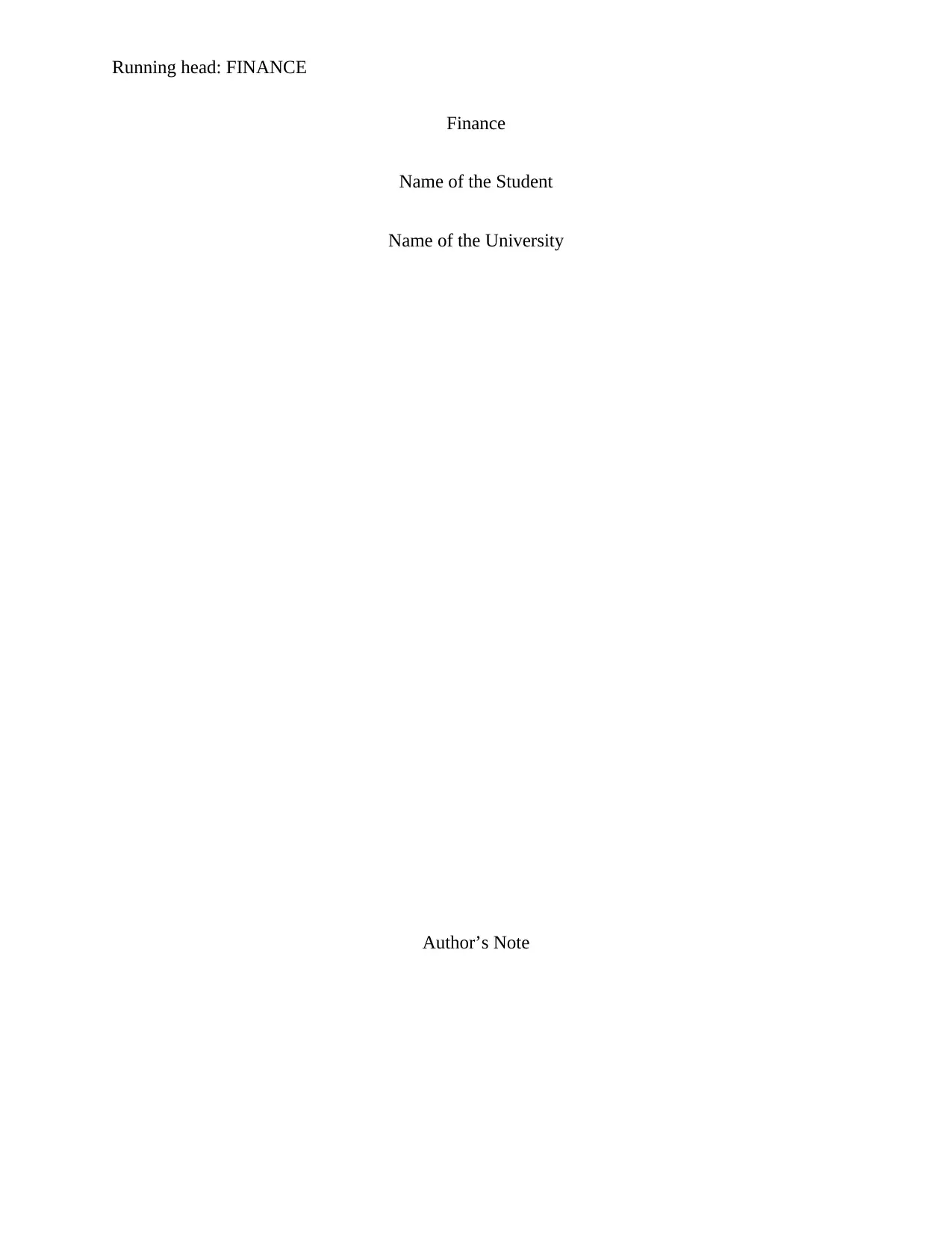
Running head: FINANCE
Finance
Name of the Student
Name of the University
Author’s Note
Finance
Name of the Student
Name of the University
Author’s Note
Paraphrase This Document
Need a fresh take? Get an instant paraphrase of this document with our AI Paraphraser
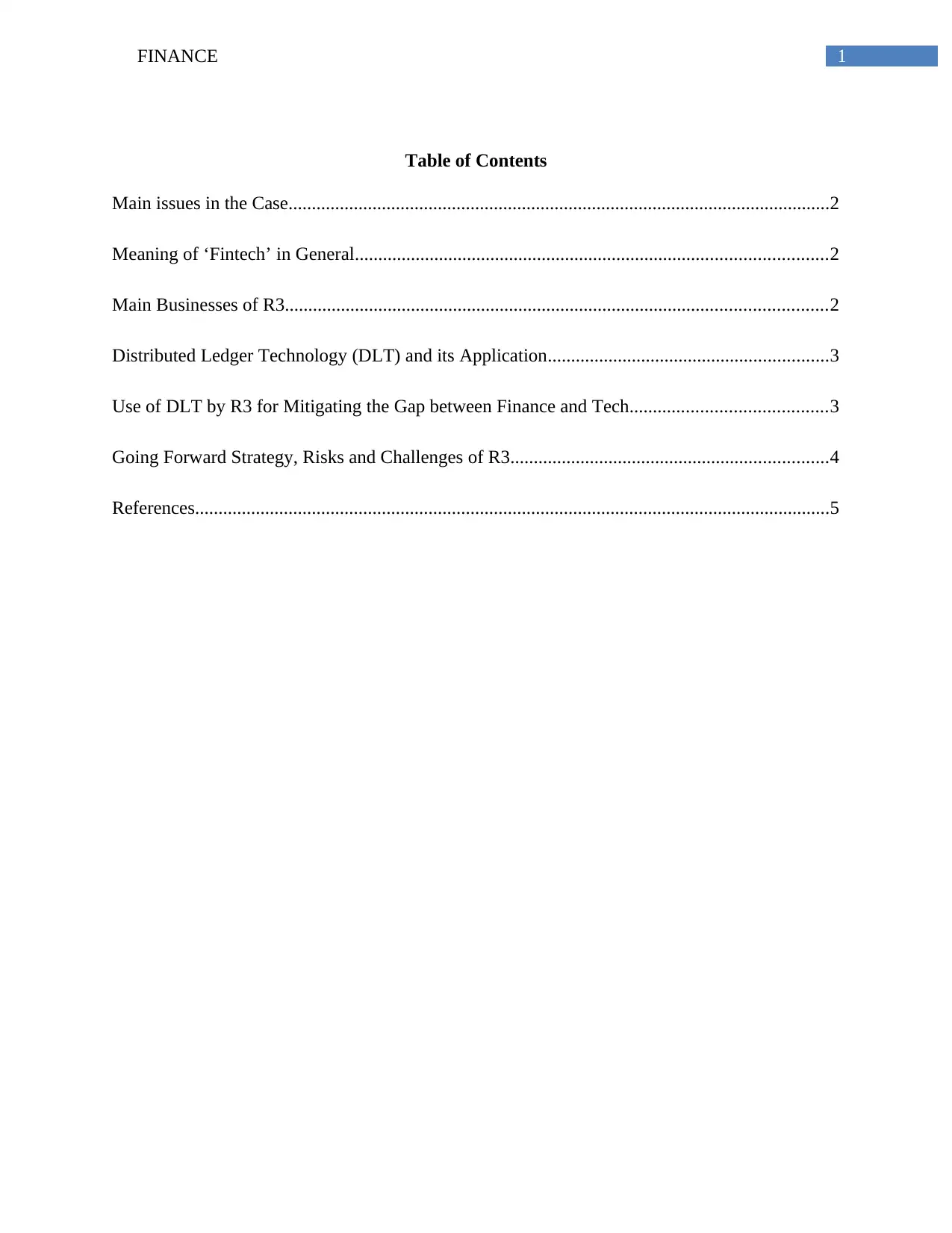
1FINANCE
Table of Contents
Main issues in the Case....................................................................................................................2
Meaning of ‘Fintech’ in General.....................................................................................................2
Main Businesses of R3....................................................................................................................2
Distributed Ledger Technology (DLT) and its Application............................................................3
Use of DLT by R3 for Mitigating the Gap between Finance and Tech..........................................3
Going Forward Strategy, Risks and Challenges of R3....................................................................4
References........................................................................................................................................5
Table of Contents
Main issues in the Case....................................................................................................................2
Meaning of ‘Fintech’ in General.....................................................................................................2
Main Businesses of R3....................................................................................................................2
Distributed Ledger Technology (DLT) and its Application............................................................3
Use of DLT by R3 for Mitigating the Gap between Finance and Tech..........................................3
Going Forward Strategy, Risks and Challenges of R3....................................................................4
References........................................................................................................................................5
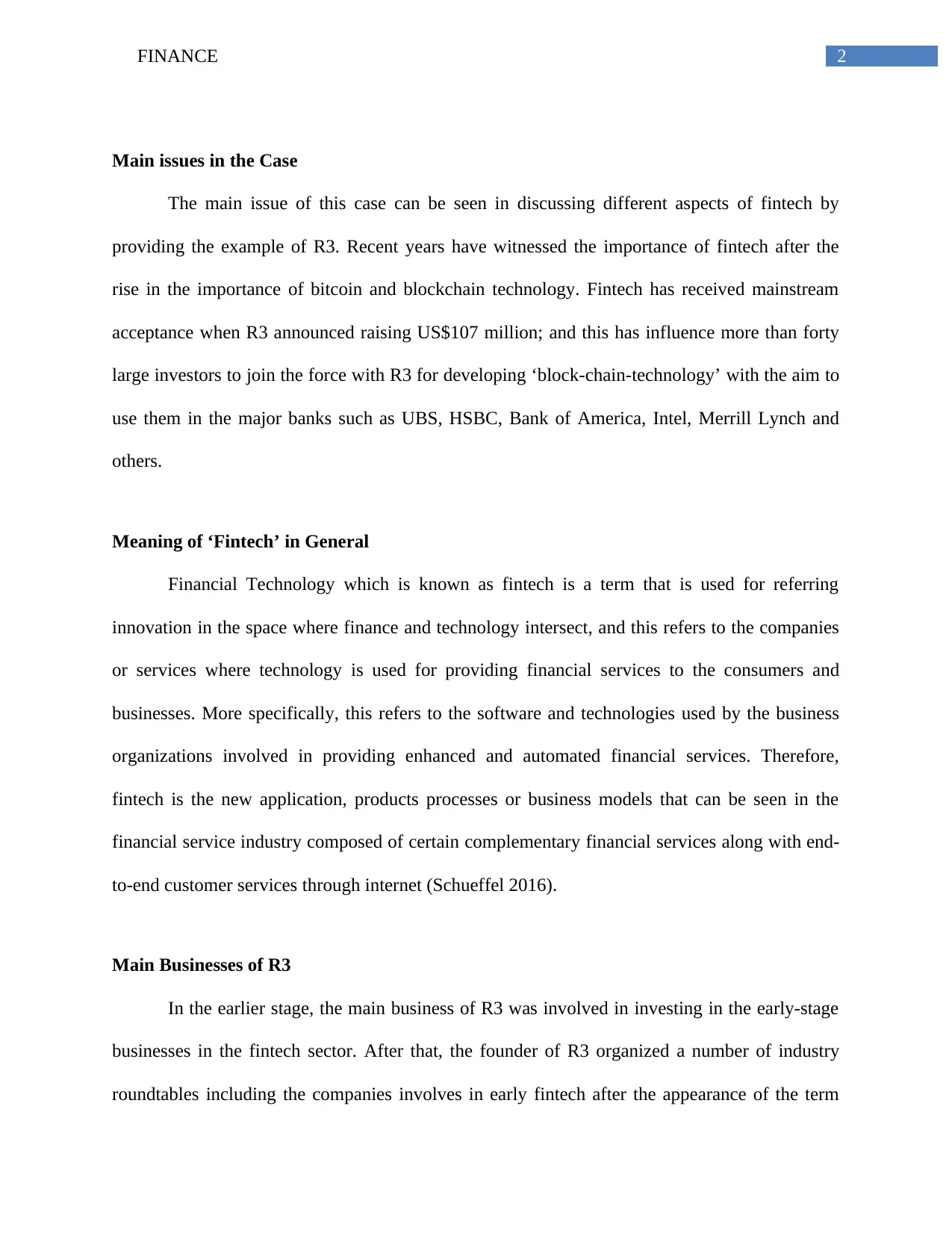
2FINANCE
Main issues in the Case
The main issue of this case can be seen in discussing different aspects of fintech by
providing the example of R3. Recent years have witnessed the importance of fintech after the
rise in the importance of bitcoin and blockchain technology. Fintech has received mainstream
acceptance when R3 announced raising US$107 million; and this has influence more than forty
large investors to join the force with R3 for developing ‘block-chain-technology’ with the aim to
use them in the major banks such as UBS, HSBC, Bank of America, Intel, Merrill Lynch and
others.
Meaning of ‘Fintech’ in General
Financial Technology which is known as fintech is a term that is used for referring
innovation in the space where finance and technology intersect, and this refers to the companies
or services where technology is used for providing financial services to the consumers and
businesses. More specifically, this refers to the software and technologies used by the business
organizations involved in providing enhanced and automated financial services. Therefore,
fintech is the new application, products processes or business models that can be seen in the
financial service industry composed of certain complementary financial services along with end-
to-end customer services through internet (Schueffel 2016).
Main Businesses of R3
In the earlier stage, the main business of R3 was involved in investing in the early-stage
businesses in the fintech sector. After that, the founder of R3 organized a number of industry
roundtables including the companies involves in early fintech after the appearance of the term
Main issues in the Case
The main issue of this case can be seen in discussing different aspects of fintech by
providing the example of R3. Recent years have witnessed the importance of fintech after the
rise in the importance of bitcoin and blockchain technology. Fintech has received mainstream
acceptance when R3 announced raising US$107 million; and this has influence more than forty
large investors to join the force with R3 for developing ‘block-chain-technology’ with the aim to
use them in the major banks such as UBS, HSBC, Bank of America, Intel, Merrill Lynch and
others.
Meaning of ‘Fintech’ in General
Financial Technology which is known as fintech is a term that is used for referring
innovation in the space where finance and technology intersect, and this refers to the companies
or services where technology is used for providing financial services to the consumers and
businesses. More specifically, this refers to the software and technologies used by the business
organizations involved in providing enhanced and automated financial services. Therefore,
fintech is the new application, products processes or business models that can be seen in the
financial service industry composed of certain complementary financial services along with end-
to-end customer services through internet (Schueffel 2016).
Main Businesses of R3
In the earlier stage, the main business of R3 was involved in investing in the early-stage
businesses in the fintech sector. After that, the founder of R3 organized a number of industry
roundtables including the companies involves in early fintech after the appearance of the term
⊘ This is a preview!⊘
Do you want full access?
Subscribe today to unlock all pages.

Trusted by 1+ million students worldwide
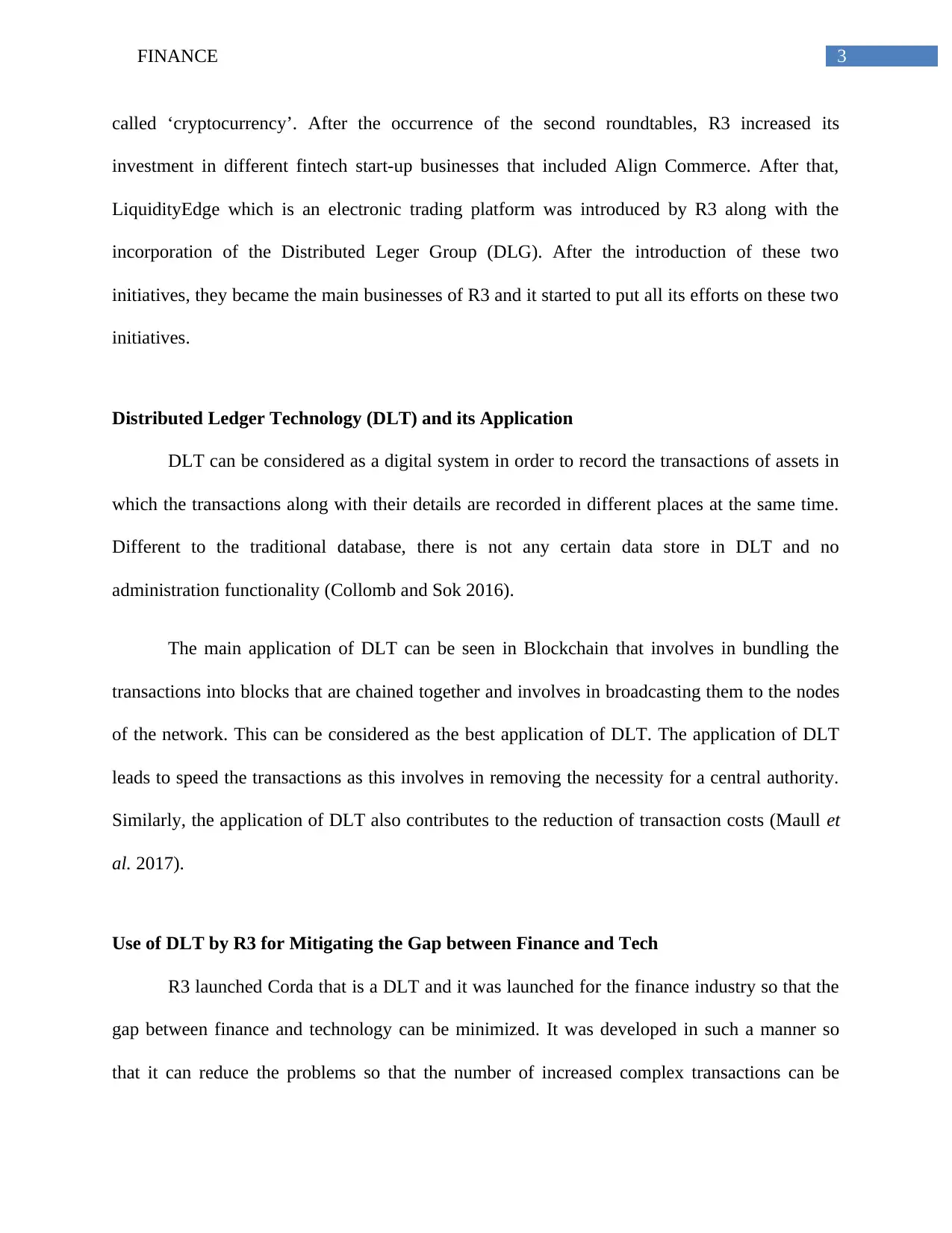
3FINANCE
called ‘cryptocurrency’. After the occurrence of the second roundtables, R3 increased its
investment in different fintech start-up businesses that included Align Commerce. After that,
LiquidityEdge which is an electronic trading platform was introduced by R3 along with the
incorporation of the Distributed Leger Group (DLG). After the introduction of these two
initiatives, they became the main businesses of R3 and it started to put all its efforts on these two
initiatives.
Distributed Ledger Technology (DLT) and its Application
DLT can be considered as a digital system in order to record the transactions of assets in
which the transactions along with their details are recorded in different places at the same time.
Different to the traditional database, there is not any certain data store in DLT and no
administration functionality (Collomb and Sok 2016).
The main application of DLT can be seen in Blockchain that involves in bundling the
transactions into blocks that are chained together and involves in broadcasting them to the nodes
of the network. This can be considered as the best application of DLT. The application of DLT
leads to speed the transactions as this involves in removing the necessity for a central authority.
Similarly, the application of DLT also contributes to the reduction of transaction costs (Maull et
al. 2017).
Use of DLT by R3 for Mitigating the Gap between Finance and Tech
R3 launched Corda that is a DLT and it was launched for the finance industry so that the
gap between finance and technology can be minimized. It was developed in such a manner so
that it can reduce the problems so that the number of increased complex transactions can be
called ‘cryptocurrency’. After the occurrence of the second roundtables, R3 increased its
investment in different fintech start-up businesses that included Align Commerce. After that,
LiquidityEdge which is an electronic trading platform was introduced by R3 along with the
incorporation of the Distributed Leger Group (DLG). After the introduction of these two
initiatives, they became the main businesses of R3 and it started to put all its efforts on these two
initiatives.
Distributed Ledger Technology (DLT) and its Application
DLT can be considered as a digital system in order to record the transactions of assets in
which the transactions along with their details are recorded in different places at the same time.
Different to the traditional database, there is not any certain data store in DLT and no
administration functionality (Collomb and Sok 2016).
The main application of DLT can be seen in Blockchain that involves in bundling the
transactions into blocks that are chained together and involves in broadcasting them to the nodes
of the network. This can be considered as the best application of DLT. The application of DLT
leads to speed the transactions as this involves in removing the necessity for a central authority.
Similarly, the application of DLT also contributes to the reduction of transaction costs (Maull et
al. 2017).
Use of DLT by R3 for Mitigating the Gap between Finance and Tech
R3 launched Corda that is a DLT and it was launched for the finance industry so that the
gap between finance and technology can be minimized. It was developed in such a manner so
that it can reduce the problems so that the number of increased complex transactions can be
Paraphrase This Document
Need a fresh take? Get an instant paraphrase of this document with our AI Paraphraser
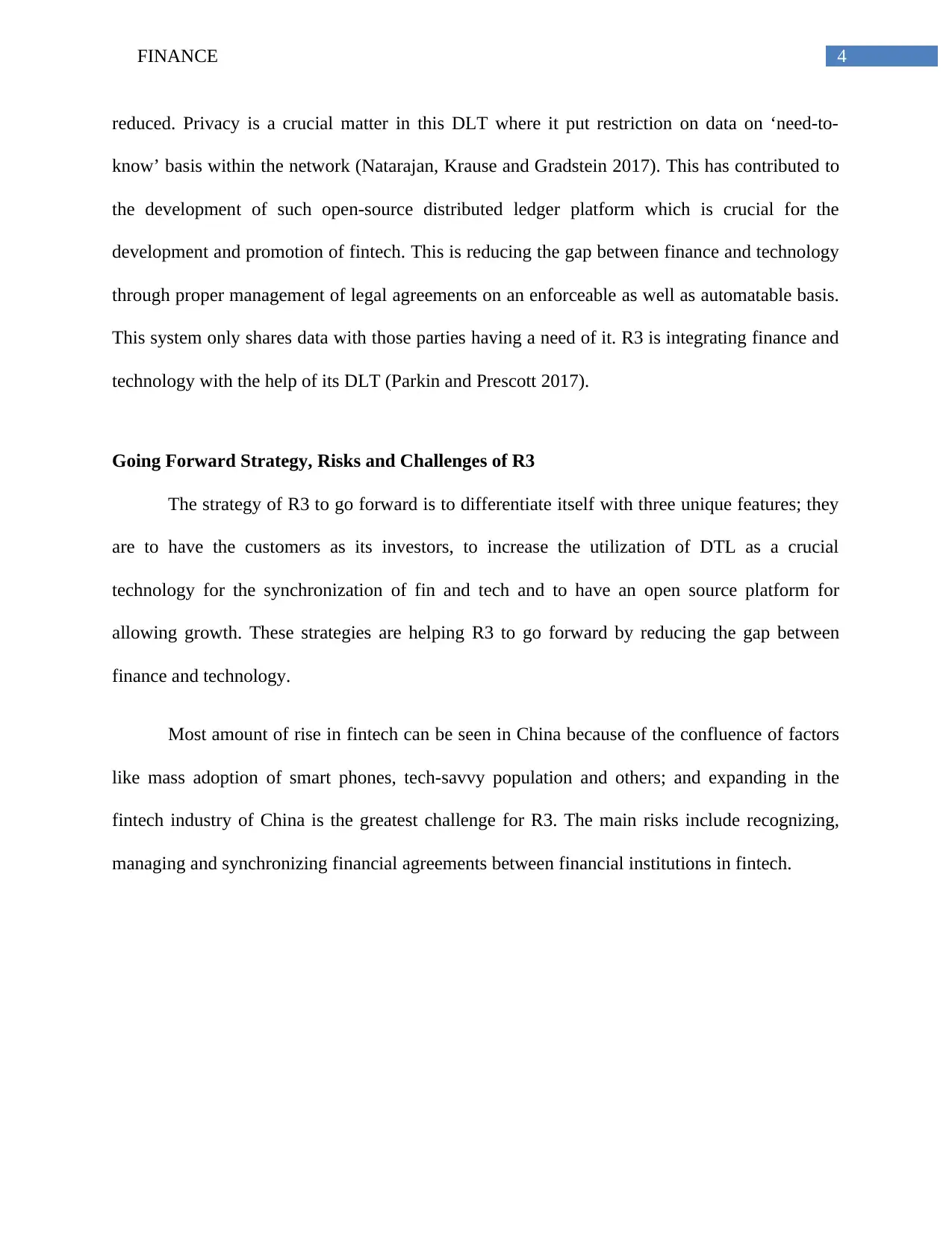
4FINANCE
reduced. Privacy is a crucial matter in this DLT where it put restriction on data on ‘need-to-
know’ basis within the network (Natarajan, Krause and Gradstein 2017). This has contributed to
the development of such open-source distributed ledger platform which is crucial for the
development and promotion of fintech. This is reducing the gap between finance and technology
through proper management of legal agreements on an enforceable as well as automatable basis.
This system only shares data with those parties having a need of it. R3 is integrating finance and
technology with the help of its DLT (Parkin and Prescott 2017).
Going Forward Strategy, Risks and Challenges of R3
The strategy of R3 to go forward is to differentiate itself with three unique features; they
are to have the customers as its investors, to increase the utilization of DTL as a crucial
technology for the synchronization of fin and tech and to have an open source platform for
allowing growth. These strategies are helping R3 to go forward by reducing the gap between
finance and technology.
Most amount of rise in fintech can be seen in China because of the confluence of factors
like mass adoption of smart phones, tech-savvy population and others; and expanding in the
fintech industry of China is the greatest challenge for R3. The main risks include recognizing,
managing and synchronizing financial agreements between financial institutions in fintech.
reduced. Privacy is a crucial matter in this DLT where it put restriction on data on ‘need-to-
know’ basis within the network (Natarajan, Krause and Gradstein 2017). This has contributed to
the development of such open-source distributed ledger platform which is crucial for the
development and promotion of fintech. This is reducing the gap between finance and technology
through proper management of legal agreements on an enforceable as well as automatable basis.
This system only shares data with those parties having a need of it. R3 is integrating finance and
technology with the help of its DLT (Parkin and Prescott 2017).
Going Forward Strategy, Risks and Challenges of R3
The strategy of R3 to go forward is to differentiate itself with three unique features; they
are to have the customers as its investors, to increase the utilization of DTL as a crucial
technology for the synchronization of fin and tech and to have an open source platform for
allowing growth. These strategies are helping R3 to go forward by reducing the gap between
finance and technology.
Most amount of rise in fintech can be seen in China because of the confluence of factors
like mass adoption of smart phones, tech-savvy population and others; and expanding in the
fintech industry of China is the greatest challenge for R3. The main risks include recognizing,
managing and synchronizing financial agreements between financial institutions in fintech.
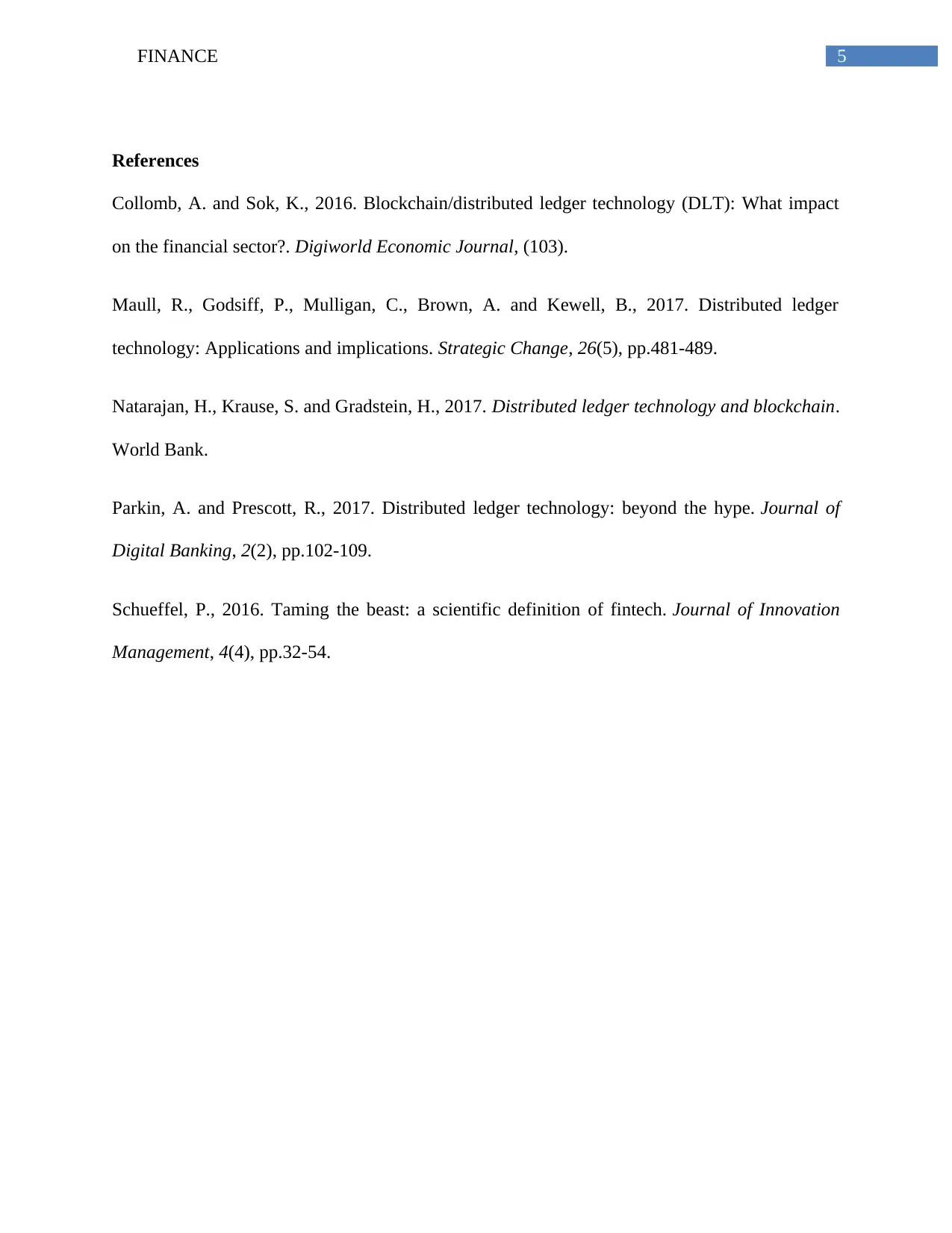
5FINANCE
References
Collomb, A. and Sok, K., 2016. Blockchain/distributed ledger technology (DLT): What impact
on the financial sector?. Digiworld Economic Journal, (103).
Maull, R., Godsiff, P., Mulligan, C., Brown, A. and Kewell, B., 2017. Distributed ledger
technology: Applications and implications. Strategic Change, 26(5), pp.481-489.
Natarajan, H., Krause, S. and Gradstein, H., 2017. Distributed ledger technology and blockchain.
World Bank.
Parkin, A. and Prescott, R., 2017. Distributed ledger technology: beyond the hype. Journal of
Digital Banking, 2(2), pp.102-109.
Schueffel, P., 2016. Taming the beast: a scientific definition of fintech. Journal of Innovation
Management, 4(4), pp.32-54.
References
Collomb, A. and Sok, K., 2016. Blockchain/distributed ledger technology (DLT): What impact
on the financial sector?. Digiworld Economic Journal, (103).
Maull, R., Godsiff, P., Mulligan, C., Brown, A. and Kewell, B., 2017. Distributed ledger
technology: Applications and implications. Strategic Change, 26(5), pp.481-489.
Natarajan, H., Krause, S. and Gradstein, H., 2017. Distributed ledger technology and blockchain.
World Bank.
Parkin, A. and Prescott, R., 2017. Distributed ledger technology: beyond the hype. Journal of
Digital Banking, 2(2), pp.102-109.
Schueffel, P., 2016. Taming the beast: a scientific definition of fintech. Journal of Innovation
Management, 4(4), pp.32-54.
⊘ This is a preview!⊘
Do you want full access?
Subscribe today to unlock all pages.

Trusted by 1+ million students worldwide
1 out of 6
Related Documents
Your All-in-One AI-Powered Toolkit for Academic Success.
+13062052269
info@desklib.com
Available 24*7 on WhatsApp / Email
![[object Object]](/_next/static/media/star-bottom.7253800d.svg)
Unlock your academic potential
Copyright © 2020–2025 A2Z Services. All Rights Reserved. Developed and managed by ZUCOL.





